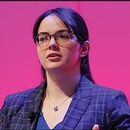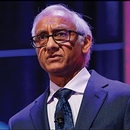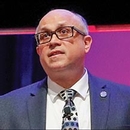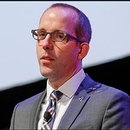The third annual Fast 5 Session on Tuesday featured five presenters from around the world speaking five minutes each on a non-clinical topic. Earlier this year the presenters pitched ideas and competed with many others for the opportunity to speak on the Arie Crown stage in this fast-paced, inspiring session moderated by Richard E. Heller III, MD, MBA.

Bridging the Gap: Patient-Centered Radiology Reports
As patients increasingly access their medical records through online health portals, the need to make reports easier to understand has grown.
"We have to remember that access does not equate to understanding," Teresa Martin-Carreras, MD, said of patient portals. "We realized that by improving the readability of our reports, we could provide our patient with immediate relief at a very difficult time."
To improve readability, Dr. Martin-Carreras and colleagues at Penn Medicine developed a system named PORTER (Patient-Oriented Radiology Reporter) which augments radiology reports with illustrations and lay-language definitions.
"The ultimate goal is to enhance patient relationships with our radiologists, because then the possibilities truly are endless," she said.

Patient-centered Lung Cancer Screening CT Clinic: Imagine What You Can Achieve
Lung cancer is the leading cause of cancer-related deaths, taking 129,000 lives each year, said Samir J. Parikh, MD, and the problem, he added, is smoking.
"We have a simple goal: Find cancer at an early stage, help the patient quit smoking and provide a unique and satisfying service," he said.
His approach is to have all new patients in the lung cancer screening clinic receive face-to-face discussion of screening results, meet with a smoking cessation counselor and work with a nurse navigator. And the results are remarkable. After screening 2,800 patients, the team found 75 cancers and improved patients' smoking quit rates from 4% to 10%.
"Patients leave very happy," Dr. Parikh said. "If I can save some lives and give those patients more time with family and friends, I have a great sense of satisfaction."

From Science Fiction to Science Fact: Imaging's Evolving Role in Monitoring & Modifying Mental Health and Social Identity
Likening modern medical advances to science fiction movies, Michael H. Lev, MD, took the audience through a series of brain imaging innovations with potential to inform strategies to improve emotional health and well-being. For instance, while prescient beings could foresee future criminal acts in the movie The Minority Report, researchers can link brain activity to future social behaviors, language ability and resilience.
"Human brains have evolved to be deeply social," Dr. Lev said, as he highlighted the many opportunities afforded through brain mapping. He showed a remarkable example in which a paralyzed patient was able to control a robotic arm with her thoughts to drink a cup of coffee.

Master the Next Level of Science Communication
"I love talking about science in a way that people can understand," said Reto Sutter, MD.
He recommended using visual communication methods to help audience members "break through the noise" of thousands of published studies to get their research read. His method of creating visual abstracts uses visual fields to simply and completely present research.
How effective is this approach? Dr. Sutter reported that the use of visual abstracts increase Tweets eight-fold and drive more than two-and-a-half times the average number of downloads for a study.

Child Care Services and Women in Radiology
The "Motherhood Penalty" causes systemic disadvantages for working women, Sherry S. Wang, MBBS, said. In fact, 69% of working mothers are passed over for jobs and 72% of mothers and fathers believe women are penalized for having a family, she said.
Working mothers often opt to participate in conferences virtually and are less likely to accept lecture invitations or submit abstracts. The solution, she said, is to actively remove the roadblocks in the career pipeline in order to achieve true equity.
"Only with changes in culture, structure and mindset can we be truly inclusive," Dr. Wang said.
One way to do this is to establish onsite child care services in hospitals to help women become more engaged at radiological meetings and improve recruitment of more women into the field.
Related links:

